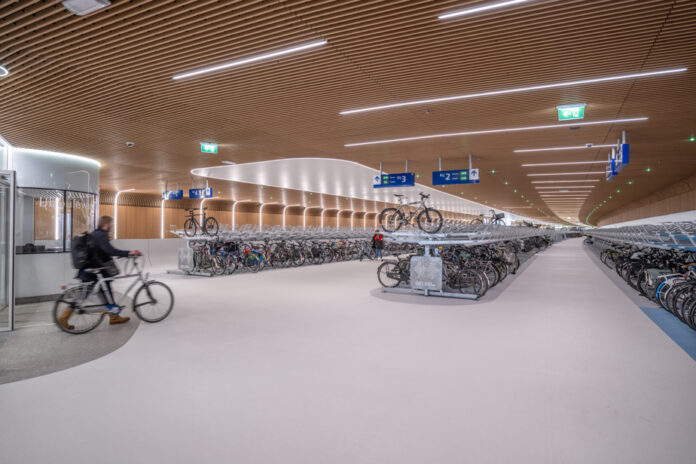The city of Amsterdam is pushing the boundaries of urban facilities for bicycles. Cyclists in the capital of the Netherlands now have access to underground bicycle parking lots, immersed under water near the Central Station.
The Amsterdam initiative is part of the desire to give space back to pedestrians, while meeting the needs of many cyclists.
“With the arrival of new underground parking lots, bike racks are disappearing from the streets,” writes the City of Amsterdam on its website. Without bike racks, the street is easier to clean, tidy, uncluttered and safe. »
Unveiled in January, a first underground facility, the Stationsplein, can accommodate up to 7,000 bicycles. And 4,000 spaces were added last February around Amsterdam Central Station, when a second hangar, the IJboulevard, opened above one of the main metro lines.
The whole project took nearly four years to come to fruition, with work beginning in 2019 on Lake IJ. The progress of the major construction site has also been documented in a video shared by the City1.
Secure at all times, both parking lots are free for the first 24 hours, before the rate increases to 1.35 euros ($1.97) per 24 hours. Tricycle, cargo bike, electric bike: spaces for all types of bicycles have been provided in the Stationsplein.
Recognized as a global pioneer of urban cycling, the Netherlands had more than 23 million bicycles on the streets in 2021, according to estimates by local mobility association RAI.
In a recent annual report2, Amsterdam reported more than 2 million kilometers traveled by citizens on bicycles every day. “Over the past 25 years, the number of daily trips has increased explosively, from 445,000 to 665,000,” it reads. So many trips in a city of about 850,000 inhabitants.
“One thing is certain, it’s something we have to strive for,” says Louis Lalonde, project manager at Vélo Québec.
The cycling culture in Quebec is not comparable to that of the Netherlands. However, the rate of Quebec adults who travel by bicycle has practically doubled since 1995, and two-wheeled trips made in the metropolis have increased by 17% between 2013 and 2018, according to Vélo Québec.
Incentive parking to maintain the curve? ” Absolutely ! This is the kind of measure that we must put in place, ”replied Louis Lalonde. Initiatives like in Amsterdam, we are starting to see them in the province, “but not in the same proportion”, assures the specialist. “It’s still a bit shy,” he admits.
Quietly, bike racks are sprouting near bus stops, commuter trains and at the doors of metro stations, he observes. Municipalities are taking the lead in developing a cycling culture: the road network is being expanded more and more to give back space to cyclists, he points out.
“Cycling is the best way to get the first and last mile. Or at least the distance that separates us from our public transport,” says Louis Lalonde.
“When there is enough safe infrastructure to get to work by combining active and collective modes, large parking lots for cars will become optional and traffic congestion will be reduced,” explains the specialist.
In Montreal alone, up to 25,000 bikes are stolen each year, says Vélo Québec. According to Louis Lalonde, “this is just the tip of the iceberg, as not everyone reports their bike stolen”.
The Garage 529 application, launched in 2021 by the Service de police de la Ville de Montréal, has reduced the number of thefts by approximately 40% in certain cities of the province. However, this will never be able to compete with “adequately” secure parking lots.
Quebec must equip itself with monitoring tools like Amsterdam does to encourage people to combine active and public transport, especially as the number of more expensive electric bicycles increases. Everyone needs to be comfortable leaving their bikes locked in public spaces all day, says Louis Lalonde. “This is what will allow us to reduce our greenhouse gases and change the mobility of people,” he concludes.


















